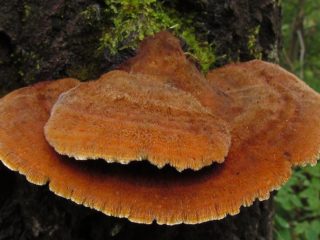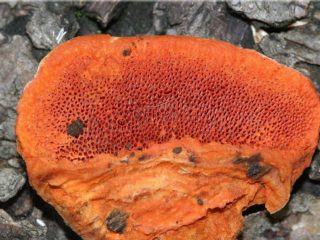Content
Polyporus cellularis is a member of the family Polypores or Polyporaceae. Unlike most of its relatives, which are parasites of deciduous trees, this species prefers to grow on their dead parts - fallen trunks, broken branches, stumps, etc. The fungus is widespread in the temperate climate zone on almost all continents of the Earth.
What does polyporus cellular look like?
The division of the cellular tinder fungus (another name is alveolar) into a stalk and a cap is very arbitrary. Externally, the mushroom is a semi- or full ring of a fruiting body attached to the trunk or branches of a tree.In most specimens the stem is either very short or absent altogether. A photo of adult fruiting bodies of the honeycomb polypore is shown below:

Fruiting bodies of Polyporus alveolarum on a fallen tree
The cap itself rarely exceeds 8 cm in diameter, and its shape depends on various factors. Most often it is round or oval. The color of the cap on top can have various shades of yellow or orange. Almost always, the surface of the upper part of the mushroom is “sprinkled” with darker scales. In older specimens this color difference is negligible.
The polyporus hymenophore has a cellular structure, which is reflected in the name of the mushroom. Each section has an elongated shape and dimensions from 1 to 5 mm. The depth can reach up to 5 mm. In fact, it is a modified tubular type of hymenophore. The color of the bottom of the cap is slightly lighter than that of the top.

The stalk of polyporus alveolaris is almost invisible
Even if the mushroom has a stalk, its length is very small, up to 10 mm. The location is usually lateral, but sometimes it is central. The surface of the stalk is covered with hymenophore cells.
Where and how does it grow
Polyporus cellularis grows in the temperate climate of the Northern Hemisphere. It can be found in Europe, Asia and America. In the Southern Hemisphere, representatives of the species are widespread in Australia.
Polyporus cellular grows on dead branches and trunks of deciduous trees. In fact, it is a saprotroph, that is, a decomposer of hard wood. The fungus is almost never found on the trunks of living plants. The mycelium of Polyporus cellularis is the so-called. “white rot” located inside dead wood.
In terms of ripening time, this species is early: the first fruiting bodies appear in mid-spring. Their formation continues until the beginning of autumn. If the summer is cold, fruiting begins in mid-June.
Typically, polyporus cellularis grows in small groups of 2-3 pieces. Sometimes larger colonies are found. Single specimens are recorded extremely rarely.
Is the mushroom edible or not?
Polyporus cellularis is classified as an edible species. This means that it can be eaten, but the process of eating the mushroom itself will be fraught with certain difficulties. Like all representatives of tinder fungi, it has very hard flesh.
Prolonged heat treatment does not eliminate this problem. Young specimens are slightly softer, but they contain a large amount of hard fibers, as, for example, in overripe eggplants. Those who have tried polyporus note its inexpressive taste and weak mushroom aroma.
Doubles and their differences
The tinder fungus in question has a unique shape, so it is quite problematic to confuse it with others. Moreover, even representatives of the Polyporidae family, although they have a similar structure of the hymenophore, but the structure of the cap and legs is completely different.
The only species with which the honeycomb polypore can be confused is its close relative, Polyporus pitata. The similarity is especially noticeable in adult and old fruiting bodies.
However, even a quick glance at the pit polypore is enough to notice the difference from the alveolar one. This representative of the mushroom kingdom has a long stalk. But the main difference is the deep notch on the cap, from which the species gets its name. In addition, there are no hymenophore cells on the leg of the pit polypore.

The characteristic differences between the pitted polypore and the cellular polypore are a long stem and a concave cap.
Conclusion
Polyporus cellularis is a fungus that grows on dead parts of the wood of deciduous trees, found everywhere in temperate climates. Its fruiting bodies are brightly colored and clearly visible from afar. The mushroom is not poisonous and can be eaten, but the taste of the pulp is very mediocre, since it is too hard and has practically no taste or smell.








